#Vasco figured out on day four
Text




✦ Coffee Shop AU ✦
#own art#own characters#CanisAlbus#art#artists on tumblr#Vasco#Machete#anthro#sighthound#dogs#canine#animals#comics#he's been trying to work up the courage to break the ice for a week and a half#Vasco figured out on day four#I don't actually know anything about coffee or what you do on coffee shop aus this was inspired by an anon ask#I like to think he's well off enough to treat himself and that's an Armani coat
12K notes
·
View notes
Note
Yo! I'm in love with your writing 😍 I hope you have a nice day
Btw can we get how all of the lookism men (and htf if it okay) would react dating/crushing on reader with big 3? (Huge tits, thick thighs and big ass). Please I'm begging you 😭🙏
lmao. semi-related: lookism hc - boobs, ass, thighs or...? Sorry anon, this is probably a lot less spicy than you were hoping, or maybe I'm too delulu with how gentlemanly some of these idiots are.
Lookism/HTF crushing on 'Big 3'
DGAF
Beauty is fine. But beauty fades and there needs to be something else there. You're never gonna turn their head with just a tight bod. They would notice something like your smile first, your wit and intelligence, your fighting prowess rather than your figure.
Zack Lee: Ride or die, loyal to a tee. Your body is just a tiny part of your overall package. In fact, feel free to lose your corporeal form. It doesn't make a difference to Zack, he will love you all the same.
DG/James Lee: He's one of the hottest, most sought after idols in South Korea. He has seen a lot of bodies. There needs to be something below the surface for his interest and attention to truly take hold.
Gun Park: Ok fine, but what can you actually do with that body? (Heh. Intepret that how you will...) If the body is just for show, then Gun is not going to be impressed. Follow it up with fighting skills and talent then this man is swooning. And also moves into the pure pest category.
Seong Taehoon: Classic friends to lover. As a friend he barely takes note of your figure. He's not blind. He knows you have a great body but this guy is a bit of a romantic, no matter how cringe he thinks that is. He'll be attracted to your personality traits, your loyalty, your kindness. Your body can be whatever. If he's fallen for you, then it's not going to make a huge difference to him.
+ Daniel Park, Jay Hong, Eli Jang, Warren Chae, Sinu Han, Xiaolong, Hudson Ahn, Kwak bros, Jason Yoon, Jerry Kwon, Baek Seongjun, Ji Yeonwoo, Seo Haesu
Doesn't even notice... at first.
"What do you mean 'huge tits, thicc thighs, big ass' on Y/N? Huh?" Once they notice, they cannot stop looking. Tries to go for a sneaky glance all the time. Puts up some pretence of being a gentleman but bro is too weak for the curves.
Jake Kim: Will absolutely notice the way your eyes light up first, how your smile warms his heart. Sure, sure. This man may play it cool(ish), but once he notices your body - it drives him wild. Finds it hard to concentrate with you around. Finds it even harder to concentrate without you around as his imagination runs wild. "Sorry Jerry, can you repeat that?"
Vasco Tabasco/Johan Seong: Thinks they are being subtle with their glances. They are not. Especially if you consider the way their face lights up bright red anytime they check you out. And if you catch them, then you can literally see them shrivel up and die before your eyes in real time.
+Jace Park, Lineman, Brad Lee, Han Wangguk, Kim Munseong
Pure pest
These guys will not keep their hands off you. Public decency be damned. The kind of bastard that will tell others to "GET A ROOM" even if they're the ones being completely inappropriate. Better keep a leash on them if you're not into being an exhibitionist.
Goo Kim: The body is a bonus. Nevertheless, it's a pretty big bonus. You will be spoiled to high heavens with clothing that this pervert likes to see you in. Figure skimming, curve hugging. Assuming you're comfortable with it. Don't be mistaken though, Goo likes seeing you in these clothes but he believes in dressing for yourself as much as for anyone else.
Samuel Seo: the most reserved out of these terrible four. He has appearances to keep up, and cares about propriety... to an extent. But will always keep a hand on your thigh or your ass. A way to claim what is his, if you will. Once he gets you on his own, his hands are roaming.
+Vin Jin, Ryuhei Kuroda
#lookism#lookism x reader#zack lee x reader#dg x reader#gun park x reader#seong taehoon x reader#taehoon x reader#seong taehun x reader#jake kim x reader#vasco x reader#johan seong x reader#goo kim x reader#samuel seo x reader#wannaeatramyeon
376 notes
·
View notes
Text
National Palace of Mafra
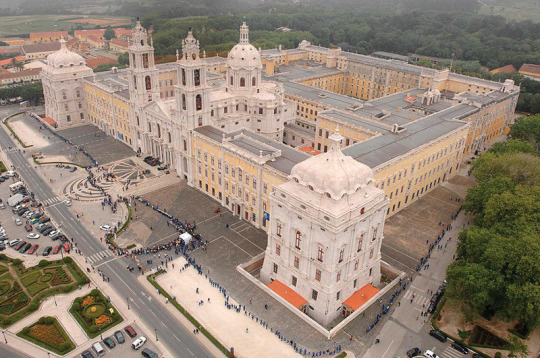
The National Palace of Mafra is located in the municipality of Mafra, in the district of Lisbon, in Portugal, about 25 kilometers from Lisbon. It consists of a monumental palace and monastery in the Johannine Baroque style, on the German side. Its construction work began in 1717 at the initiative of King D. João V, due to a promise he had made in the name of the descendants that he would obtain from Queen D. Ana Ana of Austria.
History
Due to real will, the initial project of a convent for 13 brothers was successively extended to 40, 80 and finally 300 brothers, a Basilica and a Royal Palace. However, at the date of the consecration of the Basilica, October 22nd, 1730, only the foundations of what would become the Palace were opened, which only began to be built in the following years, and was concluded near 1735.
The life of Corte in the Mafra Palace at the time of D. João V

was relatively scarce, since the King became seriously ill in 1742 and died in 1750.
His son D. José I

maintained the habit of coming to Mafra, almost always to hunt in Tapada. But, since the 1755 earthquake he did not like to live in stone buildings, the entire Royal Family was installed in a tent built next to the Palace.
In the reign of D. Maria I,

the court's visits to Mafra were linked to the celebration of religious festivals or to the taste that the Queen had for horseback riding in Tapada, a habit she maintained until she became ill in 1792.
Originally decorated with Flemish tapestries, oriental rugs, the Palace will undergo a profound modification at the will of D. João VI,
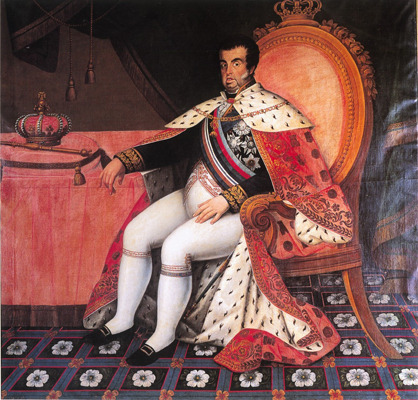
still Prince Regent, who commissioned Cyrillo Volkmar Machado
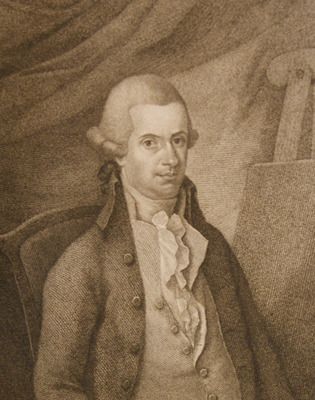
to carry out a mural decoration campaign in several rooms.
Here the entire Court settled in 1806/1807, in the troubled time that preceded the French Invasions. The need to make the large spaces of the Palace more habitable led to the division of some of the large spaces into smaller rooms, divided by wooden panels of Brazil "richly painted".
The departure of the Royal Family for Brazil, on November 27th, 1807, days before the arrival of the French troops in Lisbon, resulted in the impoverishment of much of the Palace filling, transported to the colony for the service of the Royal House and there having been left when the Court returned to Portugal in June 1821.
In December 1807, the French troops took up residence in the Palace and, a few months later, were replaced by a small fraction of the English army that remained here until March 1828.
After the troubled period of Liberal Struggles, in the reign of D. Maria II,

the Court resumed the habit of returning to Mafra. Her husband, D. Fernando,
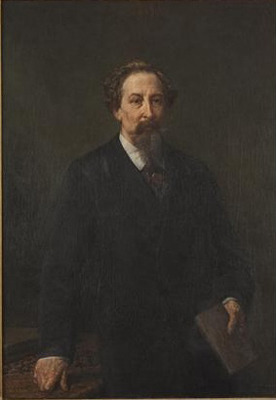
a true pioneer in the defense of national heritage, carried out several recovery works at the Real Edifício.
D. Pedro V

also came with his wife, Queen D. Estefânia de Hoenzollern-Sigmaringen,

to spend some seasons in Mafra. In this Palace, this king founded a Royal School with his name, for public instruction, supported by his pocket.
D. Luís I,

king since 1861, after the death of his brother, maintained the real protection of the School created by his brother, also coming frequently to attend the exams, often accompanied by Queen D. Maria Pia de Sabóia.

For a stay in his brother's Mafra, King Humberto of Italy, he ordered the queen to install, between the ground floor and the noble floor, an elevator operated by four men, which the palace people called shuttle or crab. This will have been one of the first elevators in our country.
Also D. Carlos

and D. Amélia,

great connoisseurs of hunting, here made frequent stays traveling the Tapada after deer and wild boar or painting, hobby that both were dedicated to.
The Mafra Palace is also associated with the end of the monarchy in Portugal, as it welcomed King D. Manuel II

on the last night he spent in the kingdom before he left for exile.
Room
Diana's room
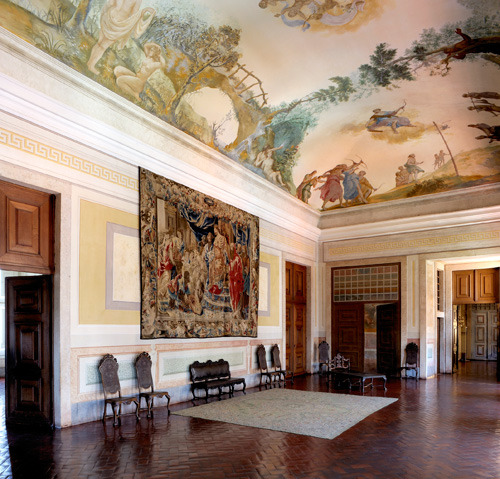
The designation is due to the ceiling painting that represents Diana, the goddess of the hunt, accompanied by nymphs and satyrs. Designed by Cirilo Volkmar Machado (1748-1823), it is part of the decorative campaign carried out since 1796 by order of the then Prince Regent, future King D. João VI. The painter was inspired by a painting by Domenichino, entitled "Hunt for Diana", existing in the Borghese Gallery in Rome.
The painting on the north wall, the door ajar in trompe-l'-oeil, represents the same goddess, also known as Selene, the goddess of the Moon, and Endimião, the shepherd with whom she fell in love.
Throne room
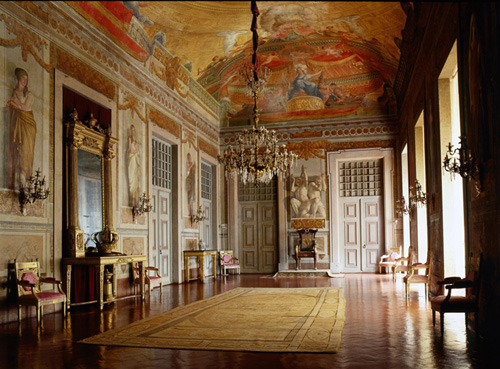
Intended for royal audiences.
The ceiling painting represents an allegory to "Lusitânia" and is part of the decorative campaign that Cirilo Volkmar Machado executed in the Palace from 1796 on behalf of the Prince Regent, future King D. João VI.
Walls decorated with fresco paintings representing the eight Royal Virtues, by Domingos Sequeira (1768-1837).
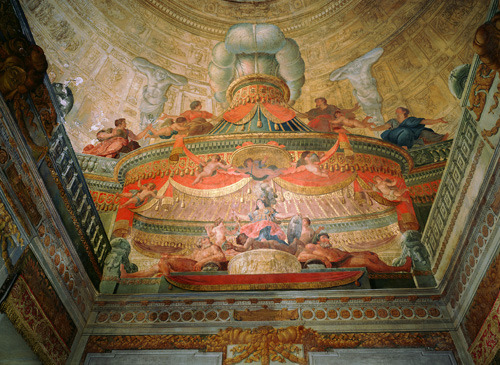
North Tower

The King's private quarters, used until the death of D. Fernando de Saxe-Cobourgo (1816/1885), husband of Queen D. Maria II, later being reserved for important guests visiting Mafra.
Each of the Paço Real turrets, north and south, functioned as an independent apartment with its kitchens in the basement, the pantries and ucharias on the ground floor, the Camaristas rooms on the 1st floor, the King's rooms on this floor and the servants in the mezzanines (attics).

Main Gallery

One of the largest palace corridors in Europe, measuring 232 m from one end to the other, connects the North Tower, the King's rooms, to the Queen's rooms in the South Tower.
Discovery Room

The ceiling painting, by Cirilo Volkmar Machado, represents the achievements of the Portuguese overseas, like Vasco da Gama overcoming Adamastor, Pedro Álvares Cabral, discoverer of Brazil, Cristóvão Colombo, discoverer of America and a portrait of Infante D. Henrique. The walls were decorated with paintings representing the exploits of the Castros, Albuquerques, Almeidas and Mascarenhas in India. These paintings went with King D. João VI to Brazil and did not return.
Destinations Room

On the ceiling, designed by Cirilo Volkmar Machado, the "Temple of Destination" is depicted, highlighting the figure of Providence that gives D. Afonso Henriques the Book of the Destinations of the Fatherland. All around, besides Hugo Capeto king of France and count D. Henrique de Borgonha, father of D. Afonso Henriques, all Portuguese monarchs up to D. João IV are represented.
Guard Room

Here the entrance to the Palace was made and the Royal Guard - which gives the name to this room - remained when the Royal Family was in Mafra.
The painting on the ceiling, by Cirilo Volkmar Machado, represents "The Precipice of Phaeton", a mythological character who, having obtained from his father Hélios the car with which he illuminated the world, losing control of the horses, endangered the Earth and the Sky Zeus, guardian of the order of the Universe, struck him with his lightning and threw him into the river Erídano.
Blessing Room

This room is the central point of the main facade that opens on the square and the Basilica.
From these balconies the Royal Family could attend religious ceremonies and, from the veranda that opens over the Terreiro, D. João V appeared to the people.
The Mafra Palace was the main building school of the 18th century in Portugal. Here they learned and worked not only engineers and architects, but specialized workers - stone carvers, joiners, glaziers and even sculptors.
For this Real Work, machines and cranes were invented that lifted large blocks of stone that sometimes required the simultaneous use of 30 or even 50 joints of oxen. It was this great constructive experience that allowed the reconstruction of Lisbon after the 1755 earthquake.
The stone used is from the region of Sintra and Pero Pinheiro, such as Amarelo de Negrais, Encarnadão “Chainette” and St. Florien Rose from Lameiras, Terrugem parish, Liós Azulino, from Maceira, Montelavar parish or Mem Martins' Negro.
South Tower
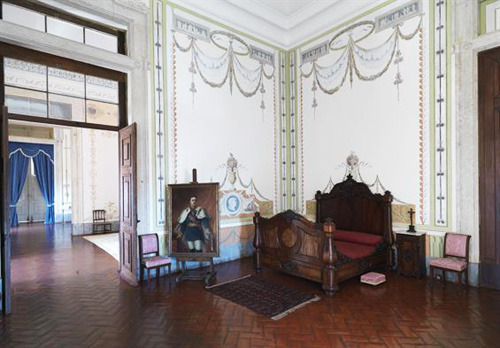
Queen's private rooms. Her Majesty's Bed Room
The mural decoration was carried out during the 1855/58 construction campaign, on the occasion of the accession to the throne of D. Pedro V and his marriage to D. Estefânia de Hohenzollern-Sigmaringen.
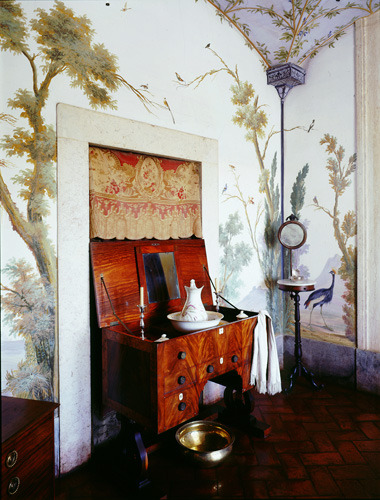


It was in this Torreão room that King D. Manuel II spent the last night in Portugal, before his departure for exile, when the Republic was implanted on October 5th, 1910.
Southern Oratory

Private chapel in the Torreão Sul rooms, originally intended for the queen.
Ceiling painting by Cirilo Volkmar Machado, ordered by the Prince Regent D. João (future king D. João VI) and his wife, D. Carlota Joaquina, at the end of the 18th century. Represents S. João Baptista, S. Carlos Borromeu and Sto. António prostrated before the Holy Trinity asking for descendants to the throne.
D. Pedro V's room

The present division and decoration reflects the romantic experience of the 19th century and dates from the works campaign carried out in this Palace when D. Pedro V ascended the throne in 1855 and his marriage to D. Estefânia de Hohenzollern-Sigmaringen in 1858.
It was also known as the Red Room or the Waiting Room, as guests waited here before being announced by the curtain wall to be received by the Royal Family in the Music Room.
Music Room

Also known as the Yellow Room or the Reception Room. The Royal Family received its guests here, replacing the Audience Room (at Torreão Norte) after D. Pedro V abolished the traditional royal hand-kiss on festive dates.
Playroom
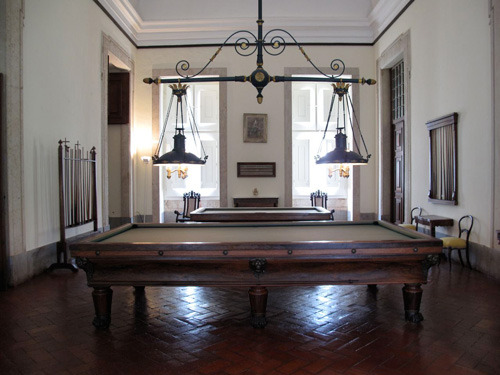
Here are some games used in the 18th and 19th centuries, such as Chinese Billiards, the pool table or "Russiana" and the game of Spinning Top.
Hunting Room

The Mafra Palace was visited regularly by the Royal Family who came here several times a year, usually to hunt in Tapada. All the furniture and decoration in this room is allusive to this taste of kings.
Dining room
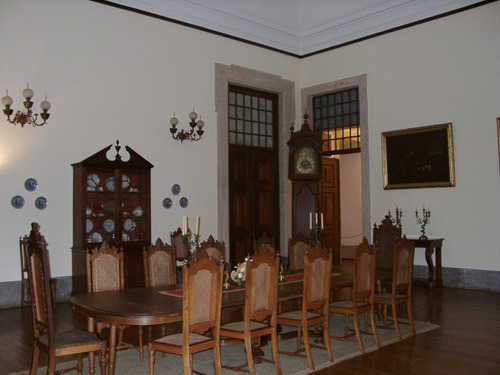
Late 19th century dining house. The table and chairs were made at the Lisbon Penitentiary and offered to King D. Carlos.
Great Hall of the Friars

Recreation of the conventual space made with the original furniture from the 18th century, since the convent was ceded to the Army since 1841. An oval table with benches that belonged to one of the Brotherhoods established by D. João V in Mafra and a lamp stand out century Dark House in wood, so called because it is used in Holy Week ceremonies.

Friar Cell
Recreation of a friar's cell in the convent, with its 18th century furniture.

Library
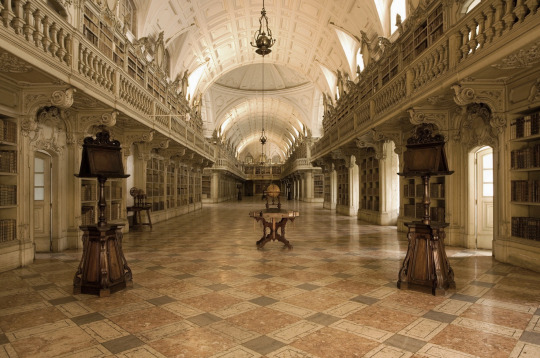
The Monastic-Royal Library of the National Palace of Mafra is one of the most important European libraries, with a valuable collection of c. of 36,000 volumes, an “ex libris” of the enlightened illustration of the century. XVIII.
Of note are some rare works such as the collection of incunabula (works printed until 1500) or the famous “Chronicle of Nuremberg” (1493), as well as several Bibles or the first Encyclopedia (known as by Diderot et D'Alembert), the Books of Illuminated hours of the 15th century and also an important nucleus of musical scores by Portuguese and foreign authors, such as Marcos Portugal, J. de Sousa, João José Baldi, among others, specially written for the group of the six historical organs of the Basilica.
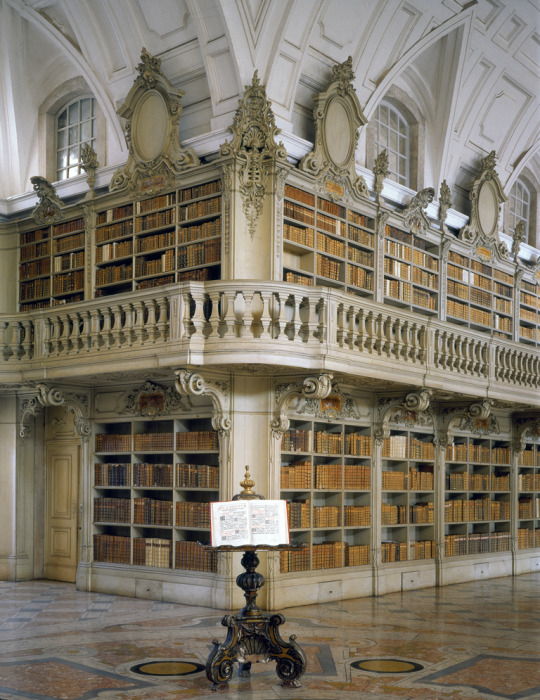
13 notes
·
View notes
Text
"If you come in at this hour, you'll have to stay forever." -Gabriel Garcia Marquez, Love in the time of Cholera
That is precisely what Goa turned out to be. South Goa grows on you, and North Goa gets you. It lures you to stay just a day longer.
As we sat waiting for the train which was to take us Goa and which was reportedly starting ten minutes and five hours late; I was left with few options other than reminiscing about my day prior to the six-hour wait: we were sitting at the Victoria Terminus ( now Chhatrapati Shivaji Maharaj terminus) in the Cidade de Bom Bahe better known as the city of Bombay gifted to the English by the Portuguese as Dowry for the wedding of Charles II to Catherine of Braganza.
The day had started early for me and I met a chubby lady called Miriam who was from Morocco in a taxi. The day showed me the southern part of the seaside city strewn here and there with jaw-dropping monuments in the Portuguese style which you’ll need to strain your necks to see the tops of. The Kala Ghoda Art district with its trademark statue of a rearing black horse. The Elphinstone college, The Gateway of India locking eyes with the Taj Hotel. And then we walked quite a walk along the roads to Marine drive and laid dead. After a stroll around the Wankhede stadium, we were back walking through the nooks, crannies; fissures and crevices of Bombay to make our way to the Terminus and did I miss mentioning a vegetarian thali meal somewhere.
The delay came ad an unpleasant blow and we talked and talked and played cards. Ages later, we boarded, slept and entered Goa at the evening and left Karmali railway station. Karmali, which is a user-friendly version of the original Carambolim. We were picked up and received at our place of stay Resort Ritchita in Calangute where the service and staff are worth mentioning for all bad reasons.
Soon all of us freshened and let loose our selves at the Cidade de Goa. A not-worth-the-money meal at Chawla Restaurant followed by a drive to Calangute beach where most of the tables were upturned on account of the late hour and the saltpetre smell rushed to our noses once we set foot into the Arabian sea: the elusive Arabian Sea. The start was good. A few drinks for some at the beach set the vibe going. We began to memorize the roads.
This slideshow requires JavaScript.
Day two
The next day began with hustle to get ready and leave for the Aguada Fort first thing. On the way, we brunched on Aloo-Paraanthas and Omelettes. Around the fort is spread an all-engulfing realm of Red clay. the fort has a lighthouse which is forbidden to enter. The parapets on the outer side offer a wide view of the Arabian sea.
The total area of Goa can be looked at as three big landmasses separated by the rivers Mandovi and Zuari. The upper one being Calangute and Candolim, the middle one, Panaji and Carambolim and the nether one, forming the South Goa, has the city of Vasco Da Gama, the namesake of its discoverer five hundred years prior.
This slideshow requires JavaScript.
A short ride down the road takes you to the rocky Aguada beach from where one gets the sight of the Aguada underground( which also means undersea) Jail all-beautiful Palacio Aguada, the Palace( holiday home ) of Parsi Business tycoon Jimmy Gazdar, more commonly known as the Millionaire’s Palace, designed by Goan architect Gerard de Cunha. Entering the palace is forbidden as Mr Jimmy Gazdar is still alive.
Another fort in the area is Reis Magos Fort, though one has to travel ten kilometres to reach there on account of no bridge over the Nerul river.
Before exploring the fort, a man made us an offer we could not refuse and told us not to tell anyone (and it turned out the offer was made to many groups and all were instructed likewise). We were offered a forty-five minutes’ boat ride in the Arabian sea at the Coco Beach for fifty and two hundred rupees a head. The boatman showed us three of the five ‘points’ we were promised and to salvage his honour, Dolphins, which were erstwhile promised did show up though they weren’t as agile as they seem on Discovery channel (they could easily have been some swimmer wearing a dolphin outfit).
Palacio Aguada from the boat
Aguada Central Jail (underground)
Fort Reis Magos takes a fifty-rupee entry fee and is every bit worth it. Unlike the Aguada Fort, it is lush green with vines hanging here and there and gives a view of the Mandovi river. The fort also houses a chamber where the Goan revolution is depicted in pictures.
However, it takes a little climb to get to the fort.
This slideshow requires JavaScript.
The day did not end yet as we made our way to Baga beach in our hired car and two scooties. Baga beach was as lively as promised. Parking rates were high, the evening sent the beach alive and canopied parasols had been erected in front of all the numerous beach-bars where the music and prices, both were skyrocketing. Beach parties rent the skies with loud and lascivious songs, a place where couples can spend a good non-silent evening. After dinner at a restaurant names Sher-A-Punjab, the caravan left. An appraisal of the day revealed that I had lost my fitness-band/watch somewhere near Aguada Beach, the same place where I had acquired four bloody cuts on my left foot and two bloody nails on different limbs which required bandages and Baga beach saw me with a bloody lip( in an attempt to open a Bacardi bottle with the teeth wherein the cap snapped along with the glass ).
Day three
The third day was the day of Beaches or the day of South Goa. Late we started, to set the Arabian sea on fire and the journey to Arossim beach took us another one and a half hour so that by the time we reached the Arossim-Colva beach line, it was well about two in the afternoon. In hindsight, the samosas in Goa are as good as, and at times better than the ones one gets in North India, mostly because the stuffing is more interesting: vegetables appear out of thin air, sometimes even tomatoes turn up.
This side of Goa is devoid of almost any noise or crowd at all. The Arossim beach is all sky-blue clear and has just one restro-bar. Strangely, all the people on the beach were foreigners, some basking in the shade of parasols and others building castles with their kids. No humans besides. This was such a tranquil place, we plunged ourselves into the water and cavorted for about an hour before drying ourselves and taking pictures and some drinks and finally taking leave.
Next, we drove back and stopped at the Japanese garden at the farthest end of the Vasco da Gama landmass. Below the garden was the Grandmother’s hole beach which was again very peaceful and serene and is one of the best places to observe a sunset. The beach is lined with dark black rocks which appear as knife-cut cubes of black ice rather than weathered rocks. The whereabouts of the beach are beautiful to look at, as will be evident from the pictures; very different from the image the word ‘Beach’ materializes in your mind.
This slideshow requires JavaScript.
The night, again drove us, as it does many, to the Baga Beach alive with beach parties. The market around the beach alone is a wonder. Here and there you find guys sitting in parking areas, crossings, selling ‘girls for parties/discos’ as chattel. One even asked us if we wanted a girlfriend. One of the many good restro-bars in the marked served as our dinner place as we enjoyed our food and drinks. Retreating to the beach, we had the time of our stay sitting on the sand, joking, laughing, talking and venturing into the sea: some quarter-sober, some not remotely so. In one of my successful forages, I brought a pair of Nike slippers out of the sea.
This slideshow requires JavaScript.
Baga the Beauty
We returned after enough of us were in their senses to drive. The night ended late.
Day four
And so the day began late, too.
We were informed by the resort staff that we had to check-out and were being accommodated elsewhere. Bad.
The new place – Yash Prapti homes, four kilometres away, was much, much better! (until someone from the staff allegedly stole our money in a moment of carelessness).The rooms were worlds better, they were two, both with balconies, the A/C was better, the mattresses were heaps plumper, the rooms were larger, the bathrooms were cleaner, the floors were better.
We freshened up, ordered some breakfast from the hotel menu which let us down, and set off in our vehicles for Old Goa this time. We had churches and Cathedrals and flea markets on our mind.
It needs to be said though, that while the roads in Goa conjure up wine-stores and bars at will, on every turn of the road, within fifty metres; it is a snowball’s chance in hell to find a medical store if you’re feeling out of sorts.
Old Goa is twenty-one kilometres by road and you need to cross the Mandovi river on the way. Most of the route lies on the highway and it takes around forty minutes to get there.
The Basilica of Bom Jesus, standing in all its momentous pride, is the main attraction. Opposite to it, on the other side of the road, is the Se Cathedral, the largest church in India.
The Basilica is four hundred years old and houses the mortal remains of St. Francis Xavier kept in a sarcophagus on the right of the altar and are brought down once every ten years for public exposition. It is said( and more strangely, believed) that the body is preserved without any chemical formula.
the Columnar architecture which characterizes a basilica. Also. the three-storied facade with the letters ‘IHS’ written on top which are the first three alphabets in the Greek word for Jesus.
beautifully gilded altar
On the left, just upon entering one sees a beautifully carved statue of St. Francis Xavier and on the right is the altar of St Anthony. The altar is flanked by altars of Our lady of hope and St Michael on the left and right. The intricately gilded main altar has a large sculpture of St Ignatius of Loyola above the figure of a baby Jesus. The top of the altar has a depiction of the holy trinity- the father, the son and the holy spirit.
the buttresses!
The chapel on the left is of the blesses sacrament and the one on the right holds the sacred relics of the saint’s body. The mausoleum has been designed by Florentine sculptor Giovanni Battista Foggini. The beautiful mausoleum, on the top of which is placed the silver casket with the body of St. Francis Xavier, was gifted by the Grand Duke of Tuscany, Cosimo III.
It also has an intricately carved pulpit with a canopy.
This slideshow requires JavaScript.
The inner courtyard has a decorated depiction of scenes from the Bible with statues of sheep and huts. There is also a light and sound show about Jesus and the Saint. On the top storey is an Art exhibition with a token entry fee of Rs. five. There are statues of St John the Baptist, Francis of Assisi, John the apostle among many others with brief biographies and a depiction of the life of St Francis Xavier in paintings. The exit has a relic shop.
This slideshow requires JavaScript.
All of this held us for much more time than a normal church holds you and so we had to skip the other churches and rush to Miramar beach in Panjim.
Miramar beach has the best array of stalls anywhere in Goa. The stalls outside the beach are numbered and are very clean and properly arranged. The prices, too, aren’t outrageous and are worth the taste. We tried some chaat and entered the beach with spices in our breath. We spent a little time appreciating the beach, and a lot of time planning what to do next and then, as we were of the opinion to suck the marrow out of life, didn’t tarry long and were off for Dona Paula.
at the Miramar beach
crabby!
cola-flavoured gola
at the Miramar beach
crabby!
cola-flavoured gola
Dona Paula is named after Paula Amaral Antonio de Souto Maior, the daughter of a Portuguese Viceroy in Sri Lanka. She was very helpful to the villagers in her time and had married an extremely affluent Fidalgo(nobleman) from Spain.
Sadly the structure was closed as it has been declared unsafe. It was evenfall by then and five of us, since we were of the opinion to suck the marrow out of life, made way for Casino Strike, Grand Hyatt Goa.
The casino part was undeniably the best part of our travel and taught us many things such as the right time to pull out with your money on the casino table, how not to fall prey to temptations, how to smuggle a slightly under-age guy into a casino( the legal age is twenty-one) and many more things.
The buffet was the best I’ve had and the drinks were good, too. Performances by beautiful Russian dancers were a big reason to stay longer in the cafe area.
All of us won good amounts before losing ourselves to temptations and then suffered downfalls, but every bit of it was enjoyed thoroughly.
This slideshow requires JavaScript.
The mood was spoiled on our way back because of two mischievous policemen who were trying to get money out of us even after we had called our colleagues with the driving license, failing to produce which, we had been held in the first place.
The night was spent amid tensions.
Day five
The last day began early and peace was restored. We checked out and headed for Chapora Fort, nine kilometres away. Chapora fort is clearly the least enjoyable fort of all the forts there are in Goa and is barely even a fort. It even needs a climb to get to the place. The sole reason for its popularity is the Bollywood movie ‘Dil Chahta Hai’.
up there is the inconsequential Chapora Fort
the arresting Vagator
We got down double quick and made way for Vagator beach nearby.
Vagator beach is a pretty busy beach and has the cheapest adventure sports packages.
It provided us with the place for a good long sunbath on the beach while two of us enjoyed the adventure sports. Later, as I found out, my nose got tanned more than other parts of my body.
After a long rest, we took on the streets to forage for food and had juices and momos for ourselves. Vagator beach area doesn’t have much of a market but we still bought us a few things before heading for Panaji in the evening where our bus waited for us.
The last supper didn’t happen at the same place for all as planned, because the restaurants don’t serve food until evenfall. Having returned our car and scooties, we took on foot and the address of the Bus Service almost deceived us into missing our bus had we not realized the mistake in time and made a run for the correct location.
We had a hard time finding the bus.
The service was Purple Grand. It was an A/C bus and everyone had a television set for watching movies. Owing to a lack of choices, I watched a goodfornothing movie and regretted instantly.
This slideshow requires JavaScript.
The ride felt very comfortable, though in the morning others said it was exceptionally bumpy.
In an appraisal of the past five days, I reckoned I had sucked pretty enough marrow out of life. Wanderbug was appeased for a while.
(or should I say ‘Wanderbug Khush Hua!’ ?)
Pictures: Sangam Kumar -> https://www.instagram.com/the_inglorious__bastard/
The Photographer:
God mode photography
You are following this blog
You are following this blog (manage).
All Roads Lead to Goa "If you come in at this hour, you'll have to stay forever." -Gabriel Garcia Marquez, Love in the time of Cholera…
#beach#church#culture#goa#heritage#india#indian culture#indianplaces#places#sea#shore#storytelling#travel#travel blog#travel post#travelblog#travelling#travelogue#travelpost#vacation#viajar#wander#wanderbug#wanderlust
0 notes
Text
Peru to the World Cup: How the journey shaped Yoshi Yotun | MLS Flight Path
August 30, 20181:13PM EDT
Like many young, aspiring soccer players in Peru, Yoshi Yotun wondered as a child how far the beautiful game might take him.
It’s taken Yotun quite, quite far. He’s traveled to Europe as a child learning the game, solidified himself in Peru as a young professional player, ventured to one of Brazil’s legendary club teams, and then got a taste of Champions League playing for a legendary Swedish team, before landing in Florida to play with MLS’s Orlando City SC.
And thanks to his involvement with Peru’s national team, he’s gone even farther: In 2017, though a wild CONMEBOL qualifying campaign throughout South America where his team won the coveted-but-dreaded intercontinental playoff spot, and then, in a winner-goes-to-the-World Cup, loser-goes-home contest which took him to New Zealand and back for the right to play in Russia against the world’s best.
Yoshi Yotun’s MLS Flight Path
Peru
Yotun, now 29, began his soccer journey began at Academia Cantalao, a top Peruvian youth academy in his hometown of Callao (within the Lima metropolitan area, housing both Peru’s primary international airport and its principal seaport). “I went to a tryout when I was eight years old, and I thank God I was actually able to make it,” he recalled. He notes that the academy develops a number of notable Peruvian players, and sends players throughout South America and even Europe to compete against some of the world’s best young players.
At 11, Yotun got to travel to and play in the Gothia Cup, a massive international youth tournament launched in 1975 and now involving teams from 80 nations. He remembers it as “a beautiful experience that helped shape me, and played a key role in my development. It helped me become the player I am today.” The pace of three games a day is beyond what he’d previously been used to, and host city Gothenburg, Sweden was many miles away from Lima, but he embraced all it had to offer – not knowing then that Sweden would figure pivotally into his soccer future.
Yotun playing for Sporting Cristal
Yotun notes that landing with Lima-based Sporting Cristal, where he began his pro career as a 17-year-old, was “the best thing that could have happened to me at that point in my career.”
“They’re one of the best clubs in Peru,” he notes. “They’re a winning and ambitious club. Winning two league titles with them is still one of the best moments of my career.” Their participation in international tournaments – and the chance for him to showcase his talent outside of Peru – was key in his decision to stay with them and develop.
Brazil
He did get the chance to play outside of Peru while still attached to Sporting Cristal, via a 2013 loan to Vasco de Gama, a Rio de Janeiro-based team in Brazil’s top-flight league.
“It was my first experience playing outside of Peru,” Yotun recalls, “in one of the best, if not the best, places for soccer in South America. I played many games for them as fullback, and feel like I grew and matured a lot. It taught me how to play in a league with a lot of high-quality players. I respect their level of play a lot.”
Yotun representing Vasco de Gama
Sweden
By 2015, the then-25-year-old Yotun was ready for new challenges, and dreamt of going to Europe. An opportunity presented itself at Malmo FF, Sweden’s most successful club team, and Yotun got to contribute to their success, helping the squad win two league titles in this two and a half seasons there.
“One of my dreams was to play in Champions League, and Malmo allowed me to do that,” Yotun recalls. He relished playing against top European teams, and in his time at Malmo, is proud to have earned the trust of his coaches. He expanded his role from left back, where he’d previously excelled, to midfield, where he got to make more decisions and have what he feels is a greater role in a team’s success.
Yotun playing for Malmo
“That change actually started with the national team,” Yotun notes. “That’s where I was first introduced to it.” Malmo is where he began to grow into the new position on the club level. “I like to keep the ball, I like to distribute it, and I like to manage the game, and so I really like playing it.”
Yotun admits that Europe, and especially Sweden, is far from family and familiar foods and surroundings. He described it as “beautiful but cold,” and found it difficult in parts because he was away from his parents, but having his wife and daughter come to Sweden with him was crucial. As he puts it, “It gave me the strength to perform and to do what I love.”
Orlando
Yotun joined Orlando City SC on August 4, 2017
Yotun would make his way to the United States – closer to home, and into a changing and evolving MLS – signing with Orlando City SC in August 2017. He recalls the club first expressed interest in December 2016, and notes that even though the negotiations were lengthy, he left in the midst of what was shaping up to be another solid Malmo season to take a chance on a league he’d never played in before.
“We were able to make it happen, and I think it’s the best decision I ever made,” he says.. “I like the team and the staff here; they’ve made it feel like home. My family loves living in this city, and if they’re happy, I’m happy, and I’m able to focus on the field. For me, it’s been very gratifying. I’m grateful for how the city has received me.”
When he was contemplating the decision, he reached out to a friend from his hometown – fellow Peruvian international player Alexander Callens, who joined NYCFC in January 2017. “He told me it was a strong league, and that it was growing a lot.” Yotun recalls. “When I got here, I was able to confirm that for myself,” remarking on both the competitive balance and how committed he is through helping the league grow.
Russia
Yotun did his part to foster that growth this summer, being one of 19 MLS players to compete in the 2018 World Cup in Russia. Though teammate Raul Ruidiaz did sign with Seattle Sounders FC just weeks after the World Cup ended, Yotun was, at the time of the tournament, the only Peru national player on an MLS roster.
Peru was one of the feel-good stories of the World Cup, qualifying for just their first World Cup since 1982. Though they were ousted in the group stages, in a group that included the eventual champions from France, they played exciting, inspired soccer which found them admirers across the globe.
“To represent your country at the World Cup is the best thing that can happen to a soccer player,” he declares. “I’ve gotten to play very many important tournaments for Peru; playing the World Cup changed our careers. We want to work hard now to make sure we get there again and allow our country to enjoy it.”
Yotun featured in all three of Peru’s World Cup group matches
Heading into the last qualifying match, Peru needed to secure a draw against Colombia to finish at least fifth in the CONMEBOL table; Yotun had been subbed off by the time the late equalizer came in the form of an own goal, yet still got to be a contributing part of one of the greatest moments in Peru soccer history.
“We as a team were always focused, with a positive attitude, to make sure we could give this joy to our country,” he recalls. “To qualify was an incredible experience.”
The November 2017 intercontinental playoff against Oceania champion New Zealand ended up being for the last spot in the World Cup — and also, in a sense, the first two matches in a World Cup that was still officially seven months away. While some thought New Zealand would be an easy opponent for Peru to dispatch, Yotun and his teammates knew better.
“We knew it was going to be difficult,” he remembers. “New Zealand is a country that has grown a lot in their soccer. It was very difficult to play there, across the world, with the time change, there were many factors that played against us.”
In the Wellignton-hosted opening leg, the teams dueled to a scoreless draw; as Yotun notes, “They could have won that match, they had many opportunities, we didn’t really play that well, but they weren’t able to score.” Four days later, the Peru team returned to Lima for the second match. As he recalls, “It was a national holiday, basically. Everybody was paying attention to this match, and we dominated it. We controlled the game and earned our path to the World Cup.” The 2-0 win delivered them into the tournament, and less than a month later, learned they’d be in a group with Australia, Denmark, and France.
On playing the team that would win the World Cup, Yotun says, “It was a special opportunity for us to play against some very talented players, and I congratulate them for what they’ve achieved.”
For Yotun, there was perhaps a touch of redemption in qualifying for the 2018 World Cup. During the qualifying process for the 2014 World Cup in Brazil, in a match against Uruguay, Yotun was given a red card for an incident involving Luis Suarez.
Toward halftime of that match, Suarez went down when a Peruvian player nudged him in the back, and as Suarez rolled on the ground, Yotun approached him, rolled the ball at him, and attempted to pull him up by the arm. The referee ejected Yotun — a move that Peru coach Sergio Markarian felt was unwarranted — but Suarez did score the game-winner against a shorthanded Peru side. Though it was one of a number of factors in Peru failing to qualify in 2014, as they finished 7th in the table, some Peru fans saw Yotun at fault.
“It was a tough moment because of everything happening around the national team,” he reflects, “But you learn from your mistakes. Obviously, that’s not going to happen again.”
And, now that Yotun and his fellow Peruvians know the joy of making the World Cup, they’ll be striving to repeat in 2022. And though Peru’s in a particularly challenging federation, Yotun brings them — quite literally — a world of experience, growing stronger with each MLS match he plays.
<!–
Stay connected: Get access to breaking news, videos, and analysis from North America’s best soccer reporters via “This Week in MLS” newsletter or using our FREE mobile app.
–>
Stay connected: The all-new, completely redesigned, FREE official MLS app is your best mobile source for scores, news, analysis and highlights. Download: App Store | Google Play
#block-block-188 {padding:0;} #stay-connected {border-top:1px solid #ebebeb;margin:20px 0;} #stay-connected p {margin:0;color:#4d4d4d;line-height:1.5em;} @media screen and (max-width: 730px) { #stay-connected {padding:8px 6px 0 6px;width:100%;} } @media screen and (min-width: 731px) and (max-width: 1120px) { #stay-connected {padding:8px 6px 0 6px;width:100%;} } @media screen and (min-width: 1121px) { #stay-connected {padding:8px 6px 0 6px;width:708px;} }
MLSsoccer.com News
Peru to the World Cup: How the journey shaped Yoshi Yotun | MLS Flight Path was originally published on 365 Football
0 notes
Text
The Red Sea
DURING THE DAY of January 29, the island of Ceylon disappeared below the horizon, and at a speed of twenty miles per hour, the Nautilus glided into the labyrinthine channels that separate the Maldive and Laccadive Islands. It likewise hugged Kiltan Island, a shore of madreporic origin discovered by Vasco da Gama in 1499 and one of nineteen chief islands in the island group of the Laccadives, located between latitude 10 degrees and 14 degrees 30' north, and between longitude 50 degrees 72' and 69 degrees east.
By then we had fared 16,220 miles, or 7,500 leagues, from our starting point in the seas of Japan.
The next day, January 30, when the Nautilus rose to the surface of the ocean, there was no more land in sight. Setting its course to the north-northwest, the ship headed toward the Gulf of Oman, carved out between Arabia and the Indian peninsula and providing access to the Persian Gulf.
This was obviously a blind alley with no possible outlet. So where was Captain Nemo taking us? I was unable to say. Which didn't satisfy the Canadian, who that day asked me where we were going.
"We're going, Mr. Ned, where the captain's fancy takes us."
"His fancy," the Canadian replied, "won't take us very far. The Persian Gulf has no outlet, and if we enter those waters, it won't be long before we return in our tracks."
"All right, we'll return, Mr. Land, and after the Persian Gulf, if the Nautilus wants to visit the Red Sea, the Strait of Bab el Mandeb is still there to let us in!"
"I don't have to tell you, sir," Ned Land replied, "that the Red Sea is just as landlocked as the gulf, since the Isthmus of Suez hasn't been cut all the way through yet; and even if it was, a boat as secretive as ours wouldn't risk a canal intersected with locks. So the Red Sea won't be our way back to Europe either."
"But I didn't say we'd return to Europe."
"What do you figure, then?"
"I figure that after visiting these unusual waterways of Arabia and Egypt, the Nautilus will go back down to the Indian Ocean, perhaps through Mozambique Channel, perhaps off the Mascarene Islands, and then make for the Cape of Good Hope."
"And once we're at the Cape of Good Hope?" the Canadian asked with typical persistence.
"Well then, we'll enter that Atlantic Ocean with which we aren't yet familiar. What's wrong, Ned my friend? Are you tired of this voyage under the seas? Are you bored with the constantly changing sight of these underwater wonders? Speaking for myself, I'll be extremely distressed to see the end of a voyage so few men will ever have a chance to make."
"But don't you realize, Professor Aronnax," the Canadian replied, "that soon we'll have been imprisoned for three whole months aboard this Nautilus?"
"No, Ned, I didn't realize it, I don't want to realize it, and I don't keep track of every day and every hour."
"But when will it be over?"
"In its appointed time. Meanwhile there's nothing we can do about it, and our discussions are futile. My gallant Ned, if you come and tell me, 'A chance to escape is available to us,' then I'll discuss it with you. But that isn't the case, and in all honesty, I don't think Captain Nemo ever ventures into European seas."
This short dialogue reveals that in my mania for the Nautilus, I was turning into the spitting image of its commander.
As for Ned Land, he ended our talk in his best speechifying style: "That's all fine and dandy. But in my humble opinion, a life in jail is a life without joy."
For four days until February 3, the Nautilus inspected the Gulf of Oman at various speeds and depths. It seemed to be traveling at random, as if hesitating over which course to follow, but it never crossed the Tropic of Cancer.
After leaving this gulf we raised Muscat for an instant, the most important town in the country of Oman. I marveled at its strange appearance in the midst of the black rocks surrounding it, against which the white of its houses and forts stood out sharply. I spotted the rounded domes of its mosques, the elegant tips of its minarets, and its fresh, leafy terraces. But it was only a fleeting vision, and the Nautilus soon sank beneath the dark waves of these waterways.
Then our ship went along at a distance of six miles from the Arabic coasts of Mahra and Hadhramaut, their undulating lines of mountains relieved by a few ancient ruins. On February 5 we finally put into the Gulf of Aden, a genuine funnel stuck into the neck of Bab el Mandeb and bottling these Indian waters in the Red Sea.
On February 6 the Nautilus cruised in sight of the city of Aden, perched on a promontory connected to the continent by a narrow isthmus, a sort of inaccessible Gibraltar whose fortifications the English rebuilt after capturing it in 1839. I glimpsed the octagonal minarets of this town, which used to be one of the wealthiest, busiest commercial centers along this coast, as the Arab historian Idrisi tells it.
I was convinced that when Captain Nemo reached this point, he would back out again; but I was mistaken, and much to my surprise, he did nothing of the sort.
The next day, February 7, we entered the Strait of Bab el Mandeb, whose name means "Gate of Tears" in the Arabic language. Twenty miles wide, it's only fifty-two kilometers long, and with the Nautilus launched at full speed, clearing it was the work of barely an hour. But I didn't see a thing, not even Perim Island where the British government built fortifications to strengthen Aden's position. There were many English and French steamers plowing this narrow passageway, liners going from Suez to Bombay, Calcutta, Melbourne, Reunion Island, and Mauritius; far too much traffic for the Nautilus to make an appearance on the surface. So it wisely stayed in midwater.
Finally, at noon, we were plowing the waves of the Red Sea.
The Red Sea: that great lake so famous in biblical traditions, seldom replenished by rains, fed by no important rivers, continually drained by a high rate of evaporation, its water level dropping a meter and a half every year! If it were fully landlocked like a lake, this odd gulf might dry up completely; on this score it's inferior to its neighbors, the Caspian Sea and the Dead Sea, whose levels lower only to the point where their evaporation exactly equals the amounts of water they take to their hearts.
This Red Sea is 2,600 kilometers long with an average width of 240. In the days of the
Ptolemies and the Roman emperors, it was a great commercial artery for the world, and when its isthmus has been cut through, it will completely regain that bygone importance that the Suez railways have already brought back in part.
I would not even attempt to understand the whim that induced Captain Nemo to take us into this gulf. But I wholeheartedly approved of the Nautilus's entering it. It adopted a medium pace, sometimes staying on the surface, sometimes diving to avoid some ship, and so I could observe both the inside and topside of this highly unusual sea.
On February 8, as early as the first hours of daylight, Mocha appeared before us: a town now in ruins, whose walls would collapse at the mere sound of a cannon, and which shelters a few leafy date trees here and there. This once-important city used to contain six public marketplaces plus twenty-six mosques, and its walls, protected by fourteen forts, fashioned a three-kilometer girdle around it.
Then the Nautilus drew near the beaches of Africa, where the sea is considerably deeper. There, through the open panels and in a midwater of crystal clarity, our ship enabled us to study wonderful bushes of shining coral and huge chunks of rock wrapped in splendid green furs of algae and fucus. What an indescribable sight, and what a variety of settings and scenery where these reefs and volcanic islands leveled off by the Libyan coast! But soon the Nautilus hugged the eastern shore where these tree forms appeared in all their glory. This was off the coast of Tihama, and there such zoophyte displays not only flourished below sea level but they also fashioned picturesque networks that unreeled as high as ten fathoms above it; the latter were more whimsical but less colorful than the former, which kept their bloom thanks to the moist vitality of the waters.
How many delightful hours I spent in this way at the lounge window! How many new specimens of underwater flora and fauna I marveled at beneath the light of our electric beacon! Mushroom-shaped fungus coral, some slate-colored sea anemone including the species Thalassianthus aster among others, organ-pipe coral arranged like flutes and just begging for a puff from the god Pan, shells unique to this sea that dwell in madreporic cavities and whose bases are twisted into squat spirals, and finally a thousand samples of a polypary I hadn't observed until then: the common sponge.
First division in the polyp group, the class Spongiaria has been created by scientists precisely for this unusual exhibit whose usefulness is beyond dispute. The sponge is definitely not a plant, as some naturalists still believe, but an animal of the lowest order, a polypary inferior even to coral. Its animal nature isn't in doubt, and we can't accept even the views of the ancients, who regarded it as halfway between plant and animal. But I must say that naturalists are not in agreement on the structural mode of sponges. For some it's a polypary, and for others, such as Professor Milne-Edwards, it's a single, solitary individual.
The class Spongiaria contains about 300 species that are encountered in a large number of seas and even in certain streams, where they've been given the name freshwater sponges. But their waters of choice are the Red Sea and the Mediterranean near the Greek Islands or the coast of Syria. These waters witness the reproduction and growth of soft, delicate bath sponges whose prices run as high as 150 francs apiece: the yellow sponge from Syria, the horn sponge from Barbary, etc. But since I had no hope of studying these zoophytes in the seaports of the Levant, from which we were separated by the insuperable Isthmus of Suez, I had to be content with observing them in the waters of the Red Sea.
So I called Conseil to my side, while at an average depth of eight to nine meters, the Nautilus slowly skimmed every beautiful rock on the easterly coast.
There sponges grew in every shape, globular, stalklike, leaflike, fingerlike. With reasonable accuracy, they lived up to their nicknames of basket sponges, chalice sponges, distaff sponges, elkhorn sponges, lion's paws, peacock's tails, and Neptune's gloves-designations bestowed on them by fishermen, more poetically inclined than scientists. A gelatinous, semifluid substance coated the fibrous tissue of these sponges, and from this tissue there escaped a steady trickle of water that, after carrying sustenance to each cell, was being expelled by a contracting movement. This jellylike substance disappears when the polyp dies, emitting ammonia as it rots. Finally nothing remains but the fibers, either gelatinous or made of horn, that constitute your household sponge, which takes on a russet hue and is used for various tasks depending on its degree of elasticity, permeability, or resistance to saturation.
These polyparies were sticking to rocks, shells of mollusks, and even the stalks of water plants. They adorned the smallest crevices, some sprawling, others standing or hanging like coral outgrowths. I told Conseil that sponges are fished up in two ways, either by dragnet or by hand. The latter method calls for the services of a diver, but it's preferable because it spares the polypary's tissue, leaving it with a much higher market value.
Other zoophytes swarming near the sponges consisted chiefly of a very elegant species of jellyfish; mollusks were represented by varieties of squid that, according to Professor Orbigny, are unique to the Red Sea; and reptiles by virgata turtles belonging to the genus Chelonia, which furnished our table with a dainty but wholesome dish.
As for fish, they were numerous and often remarkable. Here are the ones that the Nautilus's nets most frequently hauled on board: rays, including spotted rays that were oval in shape and brick red in color, their bodies strewn with erratic blue speckles and identifiable by their jagged double stings, silver-backed skates, common stingrays with stippled tails, butterfly rays that looked like huge two-meter cloaks flapping at middepth, toothless guitarfish that were a type of cartilaginous fish closer to the shark, trunkfish known as dromedaries that were one and a half feet long and had humps ending in backward-curving stings, serpentine moray eels with silver tails and bluish backs plus brown pectorals trimmed in gray piping, a species of butterfish called the fiatola decked out in thin gold stripes and the three colors of the French flag, Montague blennies four decimeters long, superb jacks handsomely embellished by seven black crosswise streaks with blue and yellow fins plus gold and silver scales, snooks, standard mullet with yellow heads, parrotfish, wrasse, triggerfish, gobies, etc., plus a thousand other fish common to the oceans we had already crossed.
On February 9 the Nautilus cruised in the widest part of the Red Sea, measuring 190 miles straight across from Suakin on the west coast to Qunfidha on the east coast.
At noon that day after our position fix, Captain Nemo climbed onto the platform, where I happened to be. I vowed not to let him go below again without at least sounding him out on his future plans. As soon as he saw me, he came over, graciously offered me a cigar, and said to me:
"Well, professor, are you pleased with this Red Sea? Have you seen enough of its hidden wonders, its fish and zoophytes, its gardens of sponges and forests of coral? Have you glimpsed the towns built on its shores?"
"Yes, Captain Nemo," I replied, "and the Nautilus is wonderfully suited to this whole survey. Ah, it's a clever boat!"
"Yes, sir, clever, daring, and invulnerable! It fears neither the Red Sea's dreadful storms nor its currents and reefs."
"Indeed," I said, "this sea is mentioned as one of the worst, and in the days of the ancients, if I'm not mistaken, it had an abominable reputation."
"Thoroughly abominable, Professor Aronnax. The Greek and Latin historians can find nothing to say in its favor, and the Greek geographer Strabo adds that it's especially rough during the rainy season and the period of summer prevailing winds. The Arab Idrisi, referring to it by the name Gulf of Colzoum, relates that ships perished in large numbers on its sandbanks and that no one risked navigating it by night. This, he claims, is a sea subject to fearful hurricanes, strewn with inhospitable islands, and 'with nothing good to offer,' either on its surface or in its depths. As a matter of fact, the same views can also be found in Arrian, Agatharchides, and Artemidorus."
"One can easily see," I answered, "that those historians didn't navigate aboard the Nautilus."
"Indeed," the captain replied with a smile, "and in this respect, the moderns aren't much farther along than the ancients. It took many centuries to discover the mechanical power of steam! Who knows whether we'll see a second Nautilus within the next 100 years! Progress is slow, Professor Aronnax."
"It's true," I replied. "Your ship is a century ahead of its time, perhaps several centuries. It would be most unfortunate if such a secret were to die with its inventor!"
Captain Nemo did not reply. After some minutes of silence:
"We were discussing," he said, "the views of ancient historians on the dangers of navigating this Red Sea?"
"True," I replied. "But weren't their fears exaggerated?"
"Yes and no, Professor Aronnax," answered Captain Nemo, who seemed to know "his Red Sea" by heart. "To a modern ship, well rigged, solidly constructed, and in control of its course thanks to obedient steam, some conditions are no longer hazardous that offered all sorts of dangers to the vessels of the ancients. Picture those early navigators venturing forth in sailboats built from planks lashed together with palm-tree ropes, caulked with powdered resin, and coated with dogfish grease. They didn't even have instruments for taking their bearings, they went by guesswork in the midst of currents they barely knew. Under such conditions, shipwrecks had to be numerous. But nowadays steamers providing service between Suez and the South Seas have nothing to fear from the fury of this gulf, despite the contrary winds of its monsoons. Their captains and passengers no longer prepare for departure with sacrifices to placate the gods, and after returning, they don't traipse in wreaths and gold ribbons to say thanks at the local temple."
"Agreed," I said. "And steam seems to have killed off all gratitude in seamen's hearts. But since you seem to have made a special study of this sea, captain, can you tell me how it got its name?"
"Many explanations exist on the subject, Professor Aronnax. Would you like to hear the views of one chronicler in the 14th century?"
"Gladly."
"This fanciful fellow claims the sea was given its name after the crossing of the Israelites, when the Pharaoh perished in those waves that came together again at Moses' command:
To mark that miraculous sequel, the sea turned a red without equal.
Thus no other course would do but to name it for its hue."
"An artistic explanation, Captain Nemo," I replied, "but I'm unable to rest content with it. So I'll ask you for your own personal views."
"Here they come. To my thinking, Professor Aronnax, this 'Red Sea' designation must be regarded as a translation of the Hebrew word 'Edrom,' and if the ancients gave it that name, it was because of the unique color of its waters."
"Until now, however, I've seen only clear waves, without any unique hue."
"Surely, but as we move ahead to the far end of this gulf, you'll note its odd appearance. I recall seeing the bay of El Tur completely red, like a lake of blood."
"And you attribute this color to the presence of microscopic algae?"
"Yes. It's a purplish, mucilaginous substance produced by those tiny buds known by the name trichodesmia, 40,000 of which are needed to occupy the space of one square millimeter. Perhaps you'll encounter them when we reach El Tur."
"Hence, Captain Nemo, this isn't the first time you've gone through the Red Sea aboard the Nautilus?"
"No, sir."
"Then, since you've already mentioned the crossing of the Israelites and the catastrophe that befell the Egyptians, I would ask if you've ever discovered any traces under the waters of that great historic event?"
"No, professor, and for an excellent reason."
"What's that?"
"It's because that same locality where Moses crossed with all his people is now so clogged with sand, camels can barely get their legs wet. You can understand that my Nautilus wouldn't have enough water for itself."
"And that locality is . . . ?" I asked.
"That locality lies a little above Suez in a sound that used to form a deep estuary when the Red Sea stretched as far as the Bitter Lakes. Now, whether or not their crossing was literally miraculous, the Israelites did cross there in returning to the Promised Land, and the Pharaoh's army did perish at precisely that locality. So I think that excavating those sands would bring to light a great many weapons and tools of Egyptian origin."
"Obviously," I replied. "And for the sake of archaeology, let's hope that sooner or later such excavations do take place, once new towns are settled on the isthmus after the Suez Canal has been cut through-a canal, by the way, of little use to a ship such as the Nautilus!"
"Surely, but of great use to the world at large," Captain Nemo said. "The ancients well understood the usefulness to commerce of connecting the Red Sea with the Mediterranean, but they never dreamed of cutting a canal between the two, and instead they picked the Nile as their link. If we can trust tradition, it was probably Egypt's King Sesostris who started digging the canal needed to join the Nile with the Red Sea. What's certain is that in 615 B.C. King Necho II was hard at work on a canal that was fed by Nile water and ran through the Egyptian plains opposite Arabia. This canal could be traveled in four days, and it was so wide, two triple-tiered galleys could pass through it abreast. Its construction was continued by Darius the Great, son of Hystaspes, and probably completed by King Ptolemy II. Strabo saw it used for shipping; but the weakness of its slope between its starting point, near Bubastis, and the Red Sea left it navigable only a few months out of the year. This canal served commerce until the century of Rome's Antonine emperors; it was then abandoned and covered with sand, subsequently reinstated by Arabia's Caliph Omar I, and finally filled in for good in 761 or 762 A.D. by Caliph Al-Mansur, in an effort to prevent supplies from reaching Mohammed ibn Abdullah, who had rebelled against him. During his Egyptian campaign, your General Napoleon Bonaparte discovered traces of this old canal in the Suez desert, and when the tide caught him by surprise, he wellnigh perished just a few hours before rejoining his regiment at Hadjaroth, the very place where Moses had pitched camp 3,300 years before him."
"Well, captain, what the ancients hesitated to undertake, Mr. de Lesseps is now finishing up; his joining of these two seas will shorten the route from Cadiz to the East Indies by 9,000 kilometers, and he'll soon change Africa into an immense island."
"Yes, Professor Aronnax, and you have every right to be proud of your fellow countryman. Such a man brings a nation more honor than the greatest commanders! Like so many others, he began with difficulties and setbacks, but he triumphed because he has the volunteer spirit. And it's sad to think that this deed, which should have been an international deed, which would have insured that any administration went down in history, will succeed only through the efforts of one man. So all hail to Mr. de Lesseps!"
"Yes, all hail to that great French citizen," I replied, quite startled by how emphatically Captain Nemo had just spoken.
"Unfortunately," he went on, "I can't take you through that Suez Canal, but the day after tomorrow, you'll be able to see the long jetties of Port Said when we're in the Mediterranean."
"In the Mediterranean!" I exclaimed.
"Yes, professor. Does that amaze you?"
"What amazes me is thinking we'll be there the day after tomorrow."
"Oh really?"
"Yes, captain, although since I've been aboard your vessel, I should have formed the habit of not being amazed by anything!"
"But what is it that startles you?"
"The thought of how hideously fast the Nautilus will need to go, if it's to double the Cape of Good Hope, circle around Africa, and lie in the open Mediterranean by the day after tomorrow."
"And who says it will circle Africa, professor? What's this talk about doubling the Cape of Good Hope?"
"But unless the Nautilus navigates on dry land and crosses over the isthmus - "
"Or under it, Professor Aronnax."
"Under it?"
"Surely," Captain Nemo replied serenely. "Under that tongue of land, nature long ago made what man today is making on its surface."
"What! There's a passageway?"
"Yes, an underground passageway that I've named the Arabian Tunnel. It starts below Suez and leads to the Bay of Pelusium."
"But isn't that isthmus only composed of quicksand?"
"To a certain depth. But at merely fifty meters, one encounters a firm foundation of rock."
"And it's by luck that you discovered this passageway?" I asked, more and more startled.
"Luck plus logic, professor, and logic even more than luck."
"Captain, I hear you, but I can't believe my ears."
"Oh, sir! The old saying still holds good: Aures habent et non audient!* Not only does this passageway exist, but I've taken advantage of it on several occasions. Without it, I wouldn't have ventured today into such a blind alley as the Red Sea."
*Latin: "They have ears but hear not." Ed.
"Is it indiscreet to ask how you discovered this tunnel?"
"Sir," the captain answered me, "there can be no secrets between men who will never leave each other."
I ignored this innuendo and waited for Captain Nemo's explanation.
"Professor," he told me, "the simple logic of the naturalist led me to discover this passageway, and I alone am familiar with it. I'd noted that in the Red Sea and the Mediterranean there exist a number of absolutely identical species of fish: eels, butterfish, greenfish, bass, jewelfish, flying fish. Certain of this fact, I wondered if there weren't a connection between the two seas. If there were, its underground current had to go from the Red Sea to the Mediterranean simply because of their difference in level. So I caught a large number of fish in the vicinity of Suez. I slipped copper rings around their tails and tossed them back into the sea. A few months later off the coast of Syria, I recaptured a few specimens of my fish, adorned with their telltale rings. So this proved to me that some connection existed between the two seas. I searched for it with my Nautilus, I discovered it, I ventured into it; and soon, professor, you also will have cleared my Arabic tunnel!"
0 notes